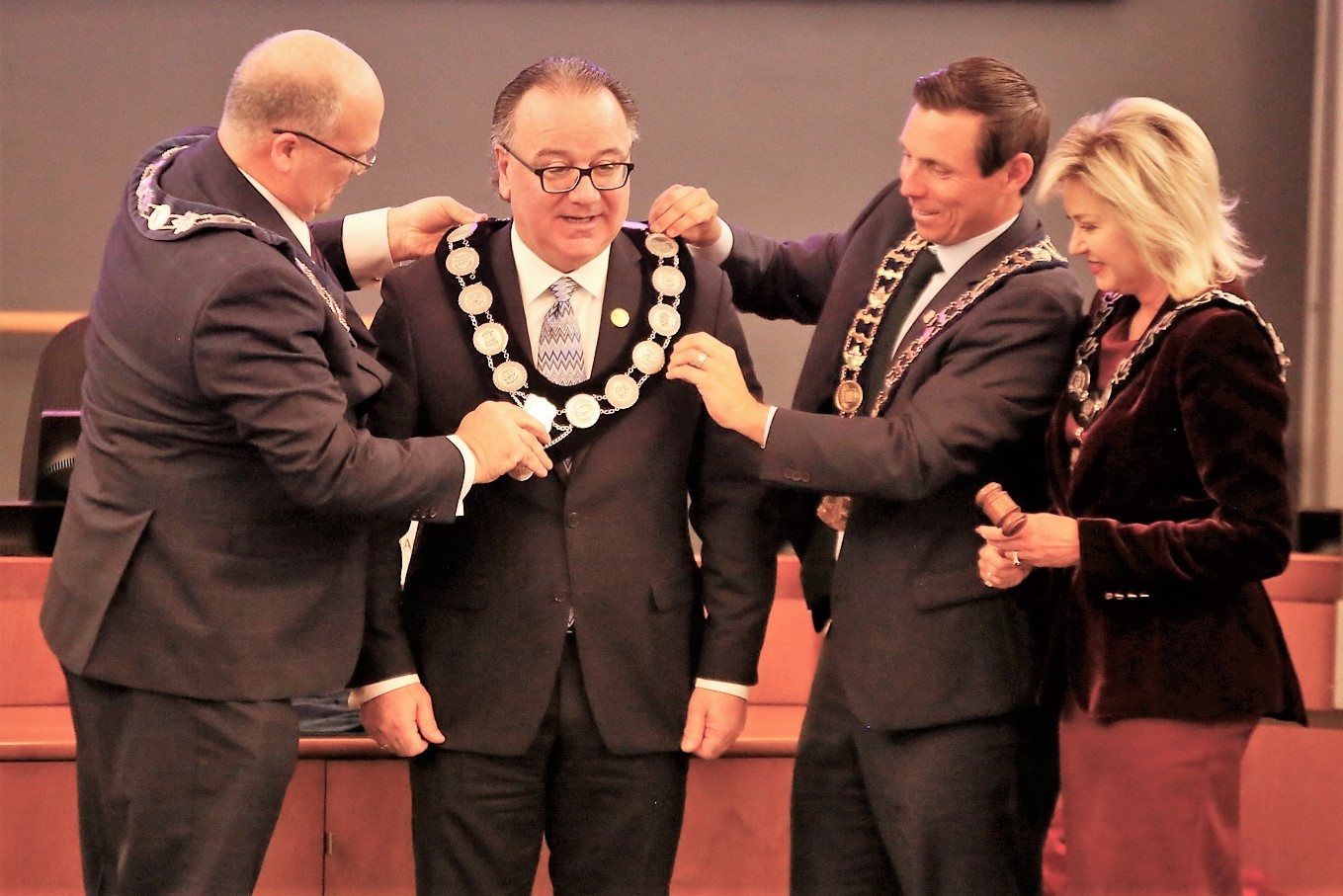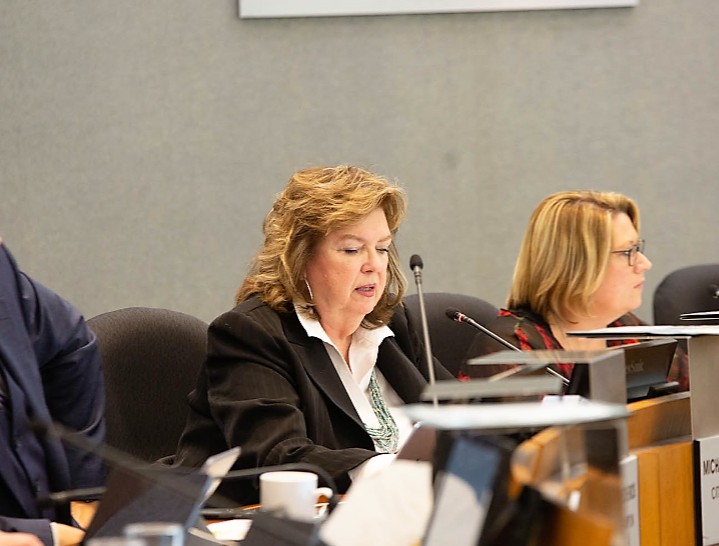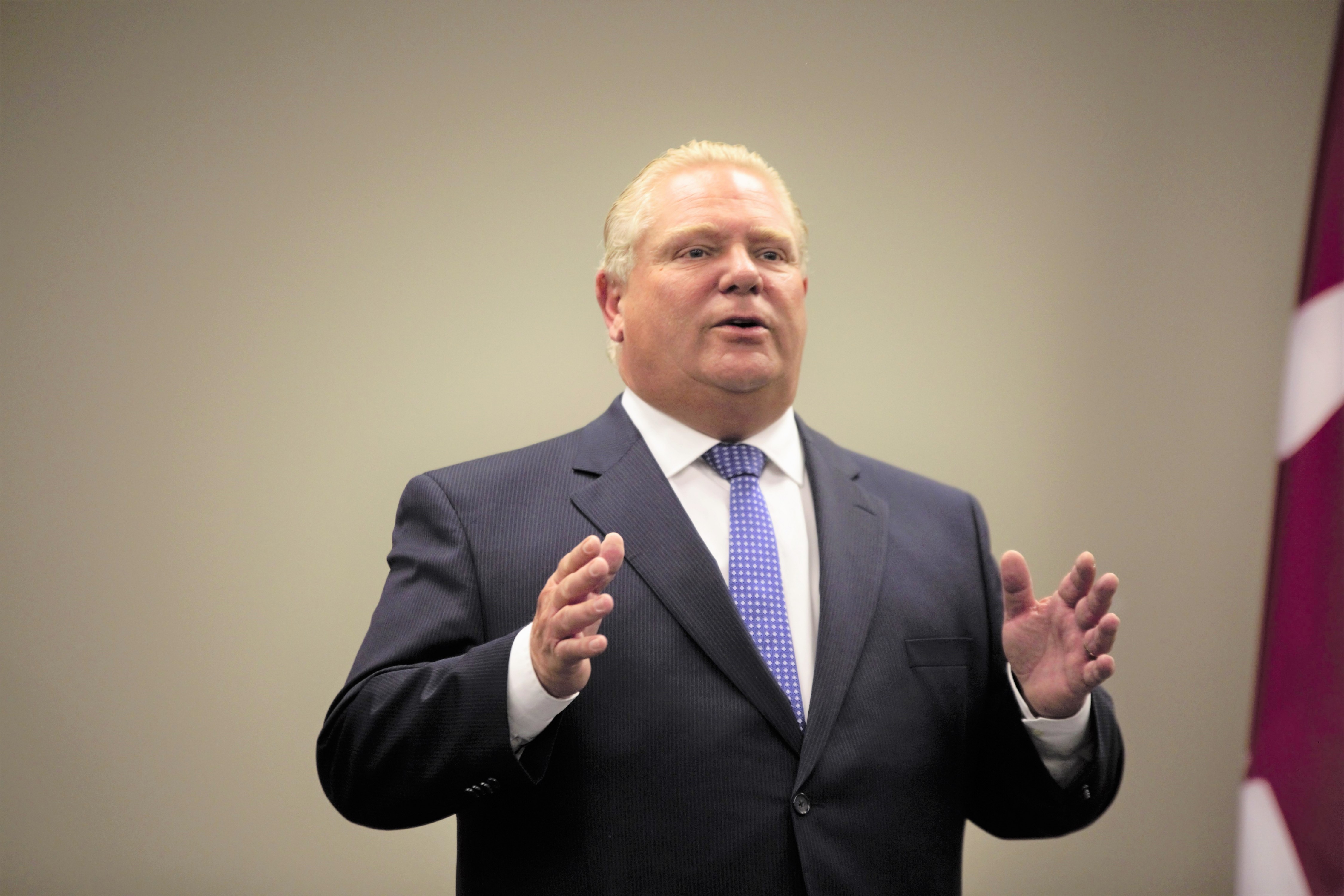
After $1 million in consultant’s fees, Brown and Crombie still don’t agree on the numbers; now Ford will determine region’s future
Brampton and Mississauga councillors are cribbing figures from a just-completed financial analysis in an attempt to bolster their respective positions on what is best for the future of Peel Region. The back and forth debate at Thursday’s Region of Peel council meeting, with each side offering contradicting interpretations of the analysis, highlights the ongoing difficulty for taxpayers to understand how any potential change in government will affect their future.
Thursday’s discussion centred on a financial report completed by Ernst and Young, which analyzes the potential financial impacts to Peel and its area municipalities should the region be dissolved or amalgamated, two of the potential outcomes of Premier Doug Ford’s regional government review launched in January across Ontario.

The three mayors put the chain of office around Peel Chair Nando Iannicca
The E&Y report was commissioned by regional council after a controversial Deloitte report that was quietly commissioned by regional chair Nando Iannicca, who wants to maintain the status quo, supported his wish. Mississauga members, who desperately want to separate, slammed him and the report, while Brown has continued to use the Deloitte findings to defend his desired outcome, to keep Peel as is.
“We get the same findings from Deloitte and EY, that (allowing Mississauga to separate) is a huge risk,” he said at Thursday’s meeting. “The continuation of the Region of Peel is in the best interest of taxpayers in Brampton, Mississauga and Caledon.”
Brown said the findings of Ernst and Young confirm the initial study completed by Deloitte, suggesting that both amalgamation and dissolution are the more costly options and focusing on the “rosy assumptions” made in the E&Y report to reach the best-case scenario, that Mississauga could save $84 million annually, is just too risky.
“If you’re a gambling person, and your chances are bad news or worse news, that’s not a good bet to make,” he said.
Mississauga councillors, in a repeat of earlier debates since Ford threw the region into a tailspin, quickly pounced on Brown.
“When you can’t win, and the facts are not in your corner, you stir up the dust,” Councillor Carolyn Parrish fired back at Brown.

Mississauga and Regional Councillor Carolyn Parrish
He promptly shot back.
“What we’ve learned is that the $84 million could be a fictional figure…You’re talking about a potential fantasy world. It could actually be a cost every year for Mississauga.”
Mississauga Mayor Bonnie Crombie said the $84 million in savings is “very achievable”.
“I would think that it’s very manageable, and no one in Mississauga foresees anything but benefit.”
After the Deloitte controversy, in an attempt to get on the same page, on May 9 council agreed to commission Ernst and Young to complete another analysis by the May 21 deadline, with a budget of $660,000, including a supporting legal document. That means E&Y was paid $600,000 for two weeks of work, that councillors are in disagreement over. It’s unclear if it will even be used by the province to make its eventual decision. The report was sent to the province just before its deadline for commentary on the regional review at midnight on May 21.
The late deadline meant that as councillors took to debating the document at Thursday’s meeting, the report was already in provincial hands, and any commentary by council could not be considered in the province’s eventual recommendation, which will be crafted behind closed doors with no public involvement.
Crombie immediately took the report as a feather in her cap, claiming it clearly backs the long-held assertion by Mississauga that Peel’s largest municipality pays more into the Region of Peel than its other municipal counterparts. In particular, Crombie pointed out that Ernst and Young came to the same conclusion as Mississauga staff, that the city stands to gain $84 million in savings annually should it become a stand-alone municipality.
“It paints a different picture from what we saw from Deloitte for sure,” she said.
In Deloitte’s analysis, dissolution (allowing Mississauga to separate) would require raising an extra $1 billion in taxes over the next 10 years to facilitate the transition. Amalgamating into one super-city, according to the controversial Deloitte report, would be cheaper, costing taxpayers about $676 million in levies over the same period.
However, according to Ernst and Young, the cost of dissolution would be much less, anywhere between $16 million and $655 million more, cumulatively, to continue to deliver all the necessary services. Ernst and Young highlight that dissolving the region would result in a shifting of the tax burden from the region down to local municipalities as the lower-tiers absorb services such as housing, human services, and policing, things currently paid for by the region through taxes that each of the three municipalities contribute.
According to Ernst and Young, following dissolution and one-time transition costs, Mississauga’s savings “range as high as” $84 million on an annual basis. However, despite repeated urgings from Mississauga councillors, Ernst and Young representative Mark MacDonald, would not comment on the potential of these savings becoming a reality, and that the $84 million figure only represents one end of a range of potential outcomes following any change in regional government.
“The entire exercise is not a prediction of the future,” he said. “We didn’t go into a prediction of, or an assessment of the probability.”
For Brampton and Caledon, they also stand to potentially see savings in the best-case scenario following dissolution, with Ernst and Young estimates suggesting these savings could be as high as $45 million for Brampton and more than $53 million for Caledon.
The report makes it clear that these figures are not set in stone, and that many assumptions were made in terms of how assets would be divided between the municipalities upon a break-up, and what would happen with regional employees, and how their salaries and pensions would be handled. The largest variable in the dissolution process would be what happens with the Peel Regional Police and how any future police services board structure is created among local municipalities. The potential outcomes for Brampton with any change to policing could mean paying $170 million to $190 million more for policing services on an annual basis.
The Ernst and Young report states that its findings are not meant to predict the future and the eventual reality could be a financial picture that does not resemble the scenarios presented in its analysis.
“The analysis rests on defined assumptions that would need to be refined as specific dimensions of any dissolution or amalgamation event would be known,” the document reads. “The analysis is restricted to a point-in-time assessment of what might happen under the conditions defined in the analysis; it is not a prediction of what will happen.”
For example, the Ernst and Young analysis assumes that in any amalgamation or dissolution scenario, when employees are transferred say from the Region of Peel to a local municipality, their wages will be harmonized to the highest comparable level for an equivalent role. Is this the way each specific position would be handled in reality? It’s uncertain.
Another such assumption has each of the area municipalities carrying the costs of transitioning to the new model chosen by the PC government (either dissolution or amalgamation) assuming no funds from the province would be available to assist with the change.

Premier Doug Ford launched the surprise review of regional governance across Ontario in January
Many of these assumptions were made in order to facilitate the full analysis, each of them approved by the steering committee for the report, made up of CAOs from each of the four governments in the two-tier structure of Peel.
And while the exercise is an attempt to gain further clarity surrounding potential futures following a change in municipal government structure, the past indicates that any such predictions are more or less futile.
Under former premier Mike Harris and his PC government’s “Common Sense Revolution”, many Ontario municipalities, including Toronto, were amalgamated under the assumption that less government would lead to less costs and more savings for taxpayers. However, following the amalgamations in the 1990s and 2000s, a study from the Fraser Institute in 2015 found that many of the cost savings the Harris PCs claimed, were never realized, in fact, costs actually went up.
“Many of the claims put forward by those favouring consolidation failed to materialize,” the Fraser report read. “In most of our cases, the per-household municipal tax burden increased. We also find that spending on certain services and remuneration also increased significantly.”
For its current review of the regional governance structure across Ontario, the Ford PCs closed the deadline for all feedback by impacted stakeholders following months of consultations by its appointed reviewers Ken Seiling and Michael Fenn. A report on potential paths forward is expected in the coming months. Following the recommendations from the advisors, the final decision for each region essentially lies with Ford, who has displayed his fondness for bold, quick moves with little to no public consultation.
This means that after almost a million dollars in consultant’s fees and several weeks of debate between regional councillors divided into their local camps, which failed to move anyone from their firm position on the desired future for Peel, there’s nothing left now but the waiting.
Email: [email protected]
Twitter: @JoeljWittnebel
Submit a correction about this story


